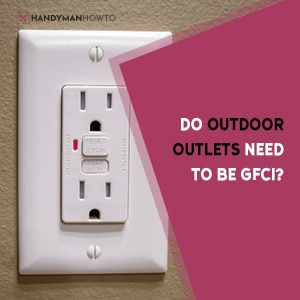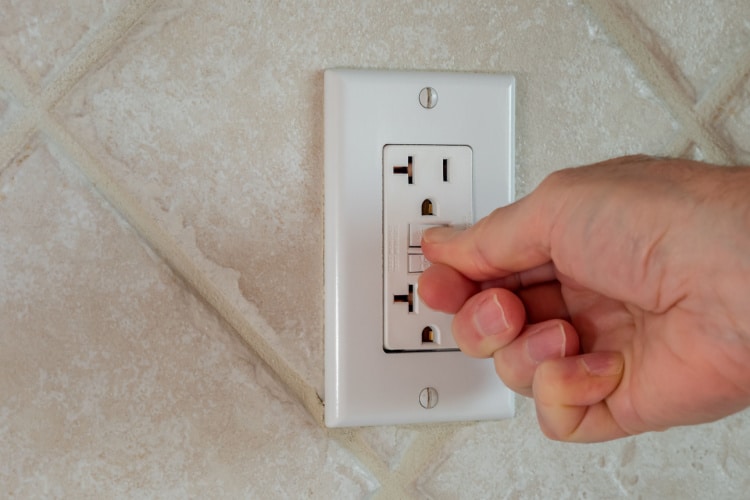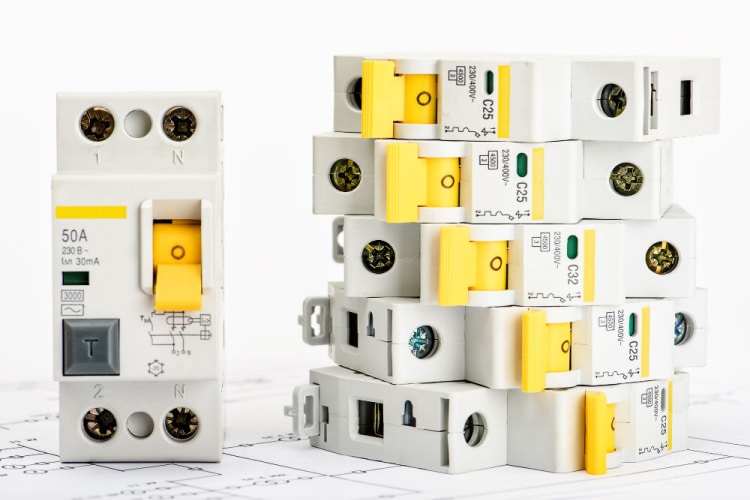When it comes to installing outlets, safety should be a top priority. In particular, one question that frequently pops up is whether outdoor outlets need to be Ground Fault Circuit Interrupter (GFCI) protected.
The answer is yes. Outdoor receptacles must be GFCI protected. GFCI outlets are designed to protect people from electrical shock, which is essential for outdoor outlets as they’re vulnerable to electrical hazards due to their exposure to the elements.

In this article, we’ll examine GFCI outlets—what they are, how they work, and why they’re essential for outdoor activities.
GFCI Outlet: The Electric Shock Protector
A GFCI outlet is a safety device that protects humans from electrical shock. It works by constantly monitoring the electrical current flow between a circuit’s hot and neutral wires.
If there is an imbalance in the current flow, signaling that some of it is flowing through an unintended path, which could be anything from water, metal, or a person’s body, the GFCI outlet quickly shuts off the electrical current. Such quick reaction time prevents electrical damage, severe injury, or even death from electrical shock.
Why Is GFCI Protection Crucial for Outdoor Outlets?
Outdoor outlets are exposed to the elements, namely rain, snow, and humidity. Because water is an excellent conductor of electricity, this exposure increases the danger of electric shock. For these reasons, GFCI protection is necessary for outdoor outlets, as they add an additional layer of safety against electrical shock.
Is GFCI Security for Outdoor Outlets Required by the NEC?
Yes, the National Electric Code (NEC) requires GFCI safety for outdoor outlets.
The NEC is a collection of guidelines for electrical installations used by states and local governments across the United States. Its goal is to protect people and property from electrical hazards.
The code requires that all 15 Amp and 20 Amp outdoor outlets have GFCI protection, which can be a GFCI circuit breaker or a GFCI receptacle. The requirement applies to all outdoor outlets and lights , including those on porches, decks, balconies, and other outdoor spaces.
GFCI protection is also mandatory for outlets in areas with a higher risk of electrical shocks, such as bathrooms, kitchens, garages, and other areas exposed to moisture and humidity.
Additionally, the NEC requires GFCI outlets to be installed by a qualified electrician and tested regularly to ensure proper operation. Testing the GFCI outlet is essential in ensuring that the ground fault protection is effective and that the outlets provide the required electrical safety.
Types of GFCI Protection
There are two types of GFCI protection for outdoor outlets: GFCI outlets and circuit breakers.
GFCI Outlets

A GFCI outlet is an electrical outlet that includes built-in GFCI protection. These outlets have a built-in sensor that monitors the electrical current flowing through the outlet. If there is an imbalance in the current flow, it will quickly shut off the power to prevent injury.
In terms of appearance, a GFCI outlet looks similar to a standard one, but with two small buttons in the center labeled “TEST” and “RESET.” The “TEST” button is used to test the GFCI protection, and the “RESET” button is used to restore power after a trip. GFCI outlets are also marked with the letters “GFCI” or “GFIC” to indicate the presence of GFCI protection.
These outlets can be installed by a licensed electrician or a knowledgeable DIYer. They are relatively easy to set up and can be a cost-effective way to improve the electrical safety in those areas.
GFCI Circuit Breakers

GFCI circuit breakers provide GFCI protection to an entire circuit. They are installed in the main electrical panel and can protect multiple outlets on that circuit.
The GFCI circuit breaker looks similar to a standard one, but with a white or yellow test button on the front face of the breaker. The button is used to test the GFCI protection. They’re also marked with the letters “GFCI” or “GFIC” to indicate the presence of GFCI protection.
The circuit breakers function just like the outlets. They include a sensor that measures the electrical current passing through the circuit. If there is an imbalance in the current flow, the GFCI circuit breaker will rapidly shut off the power to protect the user from harm.
It’s important to note that installing GFCI circuit breakers requires more knowledge and experience than installing GFCI outlets. So, they must be installed by a licensed electrician with professional experience who is familiar with the electrical code and regulations in the area.
Which One Is Better for Outdoor Use: A GFCI Outlet or a GFCI Circuit Breaker?
GFCI circuit breakers and outlets are both appropriate for outdoor use and provide excellent protection against electrical shocks.
The outlets are a good choice if you want to protect a single or a small number of receptacles. For example, if you have an outdoor receptacle that’s not on a circuit with other outdoor receptacles, you can install a GFCI outlet to provide dedicated protection for them.
GFCI circuit breakers are a good choice if you want to protect multiple outlets on a single circuit. For example, if you plan to install numerous outdoor outlets, a GFCI circuit breaker will be able to cover all of them simultaneously. Furthermore, investing in a single GFCI circuit breaker is less expensive than purchasing separate outlets with built-in GFCI protection.
Overall, both GFCI circuit breakers and outlets effectively protect against electrical shocks. The choice depends on your particular requirements regarding electricity to your outdoor space. If you’re in doubt about what you need, a licensed electrician is always available to help find the best solution for your situation.
The Benefits of Installing GFCI Protection for Outdoor Outlets
Installing GFCI safety for outdoor outlets has several advantages.
To begin with, GFCI protection lowers the risk of electrical shock and electrocution, which is particularly important in outdoor settings where people are more likely to come into contact with water or other conductors of electricity.
With GFCI protection, your outdoor outlets will meet code requirements. The NEC requires this additional protection for most outdoor outlets, so installing it guarantees compliance with building codes and regulations.
It also helps prevent harm to outdoor machinery and appliances. If the same devices are put into a typical outlet and an anomaly in the electrical current occurs, they will undoubtedly be harmed.
Furthermore, installing GFCI outlets or circuit breakers allows you to test and reset the GFCI protection easily, which helps ensure that everything functions properly and that any issues are addressed as soon as possible.
Last but not least, knowing that outdoor outlets are GFCI-protected gives homeowners peace of mind, mainly if there are children or pets in the household who may be at higher risk of electrical shock.
Conclusion
To summarize, GFCI safety is critical for outdoor outlets. Outdoor electrical equipment is exposed to water, humidity, and other conductive materials, increasing the likelihood of electrical hazards.
Both GFCI outlets and circuit breakers provide effective electrical safety protection, and the decision between the two relies on the specific needs and circumstances of the electrical installation.
If you intend to put multiple outlets in your outdoor area, use a GFCI circuit breaker. If you intend to install a single outdoor outlet, it’s better to choose a GFCI outlet.
Whichever type you go for, installing GFCI protection for outdoor outlets not only guarantees code compliance but also provides numerous advantages in terms of safety, convenience, and peace of mind.